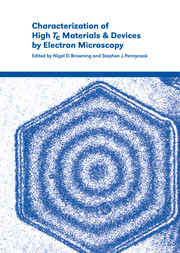Book contents
- Frontmatter
- Contents
- List of contributors
- Preface
- 1 High-resolution transmission electron microscopy
- 2 Holography in the transmission electron microscope
- 3 Microanalysis by scanning transmission electron microscopy
- 4 Specimen preparation for transmission electron microscopy
- 5 Low-temperature scanning electron microscopy
- 6 Scanning tunneling microscopy
- 7 Identification of new superconducting compounds by electron microscopy
- 8 Valence band electron energy loss spectroscopy (EELS) of oxide superconductors
- 9 Investigation of charge distribution in Bi2Sr2CaCu2O8 and YBa2Cu3O7
- 10 Grain boundaries in high Tc materials: transport properties and structure
- 11 The atomic structure and carrier concentration at grain boundaries in YBa2Cu3O7–δ
- 12 Microstructures in superconducting YBa2Cu3O7 thin films
- 13 Investigations on the microstructure of YBa2Cu3O7 thin-film edge Josephson junctions by high-resolution electron microscopy
- 14 Controlling the structure and properties of high Tc thin-film devices
5 - Low-temperature scanning electron microscopy
Published online by Cambridge University Press: 21 August 2009
- Frontmatter
- Contents
- List of contributors
- Preface
- 1 High-resolution transmission electron microscopy
- 2 Holography in the transmission electron microscope
- 3 Microanalysis by scanning transmission electron microscopy
- 4 Specimen preparation for transmission electron microscopy
- 5 Low-temperature scanning electron microscopy
- 6 Scanning tunneling microscopy
- 7 Identification of new superconducting compounds by electron microscopy
- 8 Valence band electron energy loss spectroscopy (EELS) of oxide superconductors
- 9 Investigation of charge distribution in Bi2Sr2CaCu2O8 and YBa2Cu3O7
- 10 Grain boundaries in high Tc materials: transport properties and structure
- 11 The atomic structure and carrier concentration at grain boundaries in YBa2Cu3O7–δ
- 12 Microstructures in superconducting YBa2Cu3O7 thin films
- 13 Investigations on the microstructure of YBa2Cu3O7 thin-film edge Josephson junctions by high-resolution electron microscopy
- 14 Controlling the structure and properties of high Tc thin-film devices
Summary
Introduction
Scanning techniques for obtaining topographical information about an object are now widely used in science and technology. Usually, a two-dimensional image is constructed from the signal generated by the scanning process, and this information is restricted to a region close to the sample surface. [5.1]. Here a well focused electron beam is scanned over the surface of the specimen and a response signal such as the emitted secondary electrons or the back-scattered electrons are recorded as a function of the coordinate point (x, y) of the beam focus on the sample surface. We emphasize that this technique essentially yields only information about the composition (atomic, chemical, or metallurgical microstructure) and the geometry of the specimen.
Some time ago, low-temperature scanning electron microscopy (LTSEM) was introduced [5.2] which by now has matured into an important new diagnostic tool. LTSEM extends the temperature of scanning electron microscopy to the regime of liquid helium and liquid nitrogen by providing the necessary sample cooling. However, more importantly, LTSEM yields information on the local electronic function and not just the local structure with high spatial resolution. In this way it has provided important input for the understanding of the physics of superconducting electronic circuits and devices. Of course, LTSEM is equally important for the evaluation and analysis of low Tc and high Tc superconductors. The principle of LTSEM utilizes the electron beam as a local heat source on the one hand, and the sensitive response of superconductors to small temperature changes on the other hand [5.2].
- Type
- Chapter
- Information
- Publisher: Cambridge University PressPrint publication year: 2000

